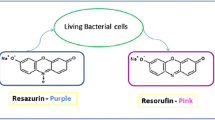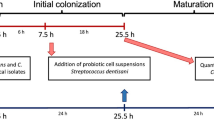Abstract
Comparative studies were carried out of the fungal resistance of thiokol sealants to micromycetes isolated in the tropical climate of the Republic of Cuba and micromycetes used as test cultures according to GOST (State Standard) 9.049–91. The growth of both groups of microorganisms was revealed on samples of sealants vulcanized with manganese dioxide, and almost no growth was detected on samples of sealants vulcanized with sodium dichromate. Tropical micromycetes have been shown to be more active against sealing materials than standard cultures.




Similar content being viewed by others
REFERENCES
C. Vallieres, A.L. Hook, Y. He, et al., “Discovery of (meth)acrylate polymers that resist colonization by fungi associated with pathogenesis and biodeterioration,” Sci. Adv. 6 (23), Eaba6574 (2020). https://doi.org/10.1126/sciadv.aba6574
S. A. Semenov, K. Z. Gumargalieva, and G. E. Zaikov, “Biodamaging of materials and engineering products,” in Combustion, Destruction, and Stabilization of Polymers (Nauchnye Osnovy i Tekhnologii, St. Petersburg, 2008), pp. 73–99.
E. N. Kablov, “Key problem—materials,” in Trends and Guidelines of Innovative Development of Russia (All-Russian Institute of Aviation Materials, Moscow, 2015), pp. 458–464.
E. N. Kablov and V. O. Startsev, “System analysis of the influence of climate on the mechanical properties of polymer composite materials according to domestic and foreign sources (a review),” Aviats. Mater. Tekhnol., No. 2, 40–46 (2018). https://doi.org/10.18577/2071-9140-2018-0-2-47-58
F. Schmidt, Y.-S. Zimmermann, G. A. R. Benatto, et al., “Biodeterioration affecting efficiency and lifetime of plastic-based photovoltaics,” Joule 4 (10), 2088–2100 (2020). https://doi.org/10.1016/j.joule.2020.08.015
M. Y. Stepanova and N. I. Baurova, “Analysis of methods for determining the biostability of polymer composite materiales used in mechanical engineering,” Polym. Sci., Ser. D 13, 345–348 (2020). https://doi.org/10.1134/S1995421220030193
E. N. Kablov, V. T. Erofeev, D. A. Svetlov, V. F. Smirnov, and A. D. Bogatov, “Biodeterioration in spacecraft,” in Proceedings of the International Scientific-Technical Conf. “Composite Materials: Theory and Practice” (Privolzhskii Dom Znanii, Penza, 2015), pp. 40–46.
A. V. Polyakova, A. A. Krivushina, Yu. S. Goryashnik, and G. M. Bukharev, “Testing of microbiological resistance in natural conditions of various climatic zones,” Tr. Vseross. Inst. Aviats. Mater., No. 4, 12 (2016). https://doi.org/10.18577/2307-6046-2016-0-4-12-12
A. V. Polyakova, Yu. S. Goryashnik, G. M. Bukharev, and O. A. Eliseev, “Fungal resistance of sealants,” Polym. Sci., Ser. D 9, 195–198 (2016). https://doi.org/10.1134/S1995421216020180
O. A. Eliseev, Ya. A. Bryk, and D. N. Smirnov, “Modification of polysulfide sealants with corrosion inhibitors,” Aviats. Mater. Tekhnol., No. 2 (44), 15–21 (2016). https://doi.org/10.18577/2071-9140-2016-0-S2-15-21
Ya. A. Bryk, O. A. Eliseev, and D. N. Smirnov, “Corrosion protection of magnesium alloys with polysulfide sealants,” Tr. Vseross. Inst. Aviats. Mater., No. 10, 10 (2017). https://doi.org/10.18577/2307-6046-2017-0-10-10-10
A. A. Krivushina and Yu. S. Goryashnik, “Methods of protecting materials and products from microbiological deterioration (a review),” Aviats. Mater. Tekhnol., No. 2 (47), 80–86 (2017). https://doi.org/10.18577/2071-9140-2017-0-2-80-86
S. Ghramrawi, J.-P. Bouchara, A. Corbin, et al., “Inhibition of fungal growth by silicones modified with cationic biocides,” Mater. Today: Commun. 22, 100716 (2020). https://doi.org/10.1016/j.mtcomm.2019.100716
C. Vallieres, A. L. Hook, J. He, et al., “Discovery of (meth)acrylate polymers that resist colonization by fungi associated with pathogenesis and biodeterioration,” Appl. Sci. Eng. 6 (23), 6574 (2020). https://doi.org/10.1126/sciadv.aba6574
Funding
This study was supported by the Russian Foundation for Basic Research, project no. 18-53-34006.
Author information
Authors and Affiliations
Corresponding author
Ethics declarations
COMPLIANCE WITH ETHICAL STANDARDS
This article does not contain any studies involving animals or human participants performed by any of the authors.
CONFLICT OF INTEREST
The authors declare that they have no conflicts of interest.
Additional information
Translated by A. Bulaev
Rights and permissions
About this article
Cite this article
Krivushina, A.A., Bobyreva, T.V. & Smirnov, D.N. Fungal Resistance of Thiokol Sealants to Tropical Microorganisms and Test Cultures. Part 1. Polym. Sci. Ser. D 15, 177–182 (2022). https://doi.org/10.1134/S1995421222020149
Received:
Revised:
Accepted:
Published:
Issue Date:
DOI: https://doi.org/10.1134/S1995421222020149




